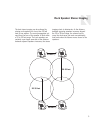
Number of Speaker Pairs
First, determine the size of the listening area,
and identify any gathering areas where folks
will sit or stand. The typical coverage area is
20 feet from the front of the speaker for nor-
mal listening levels. There should be a maxi-
mum of 20 feet between speakers for better
stereo imaging. Too far away from each other
creates an acoustic void when used for
stereo. Monaural will not be affected to the
same degree.
Use as many pairs of speakers as needed to
achieve the desired coverage and dispersion
of sound. Getting more sound with more
speakers is better than cranking the volume,
which may lead to amp clipping. Large areas
are better served by monaural audio instead
of stereo. In most outdoor environments,
there is no ideal listening area to give stereo
image or separation.
Tools Needed for Installation
• Wire strippers
• Hacksaw or pipe cutter
• Spade or trench tool
• Direct burial rated speaker cable
(Polarity indication should be on the cable)
16AWG minimum - for distances up to 75ft.
14AWG - from 75 to 125 feet
12AWG - from 125 to 175 feet
• PVC conduit, cleaner and cement (optional)
• Silicone caulking
Planning Path for Cable Burial
First, consult your local phone and/or electric
company to learn of existing buried cables or
pipes. Watch for buried water lines or gas
lines. If necessary, use a metal detector to
discover buried cables. Be aware of any local
building code requirements that may be appli-
cable.
Trenching and Burying Cable
To ensure proper installation of direct burial
speaker cable, consult the manufacturer of
the cable you are using, and adhere to all
applicable electrical codes.
After positioning the speakers and determin-
ing where any buried obstructions exist, you
can dig the trench. Lay the cable out on top
of the ground from the speaker to the outdoor
volume control to determine length.
Make cable connections at the speaker. Be
sure to observe polarity. Make connections at
the amplifier, and test the system to see if
everything is working properly.
Trench below the frost line for the cable. The
frost line will vary depending on geography,
and is typically no deeper than three feet.
If using conduit, size and cut it to length.
Connect the conduit lengths and elbows with
PVC cement. Ensure all electrical connections
are watertight; seal with additional silicone if
necessary. Run cable through the conduit.
Bury the cable or conduit in the trench, and
leave an extra 3 feet of cable under the
speaker to allow for future adjustments in
position.
Seal the cable paths through structure walls
with silicone.
Installation
3










